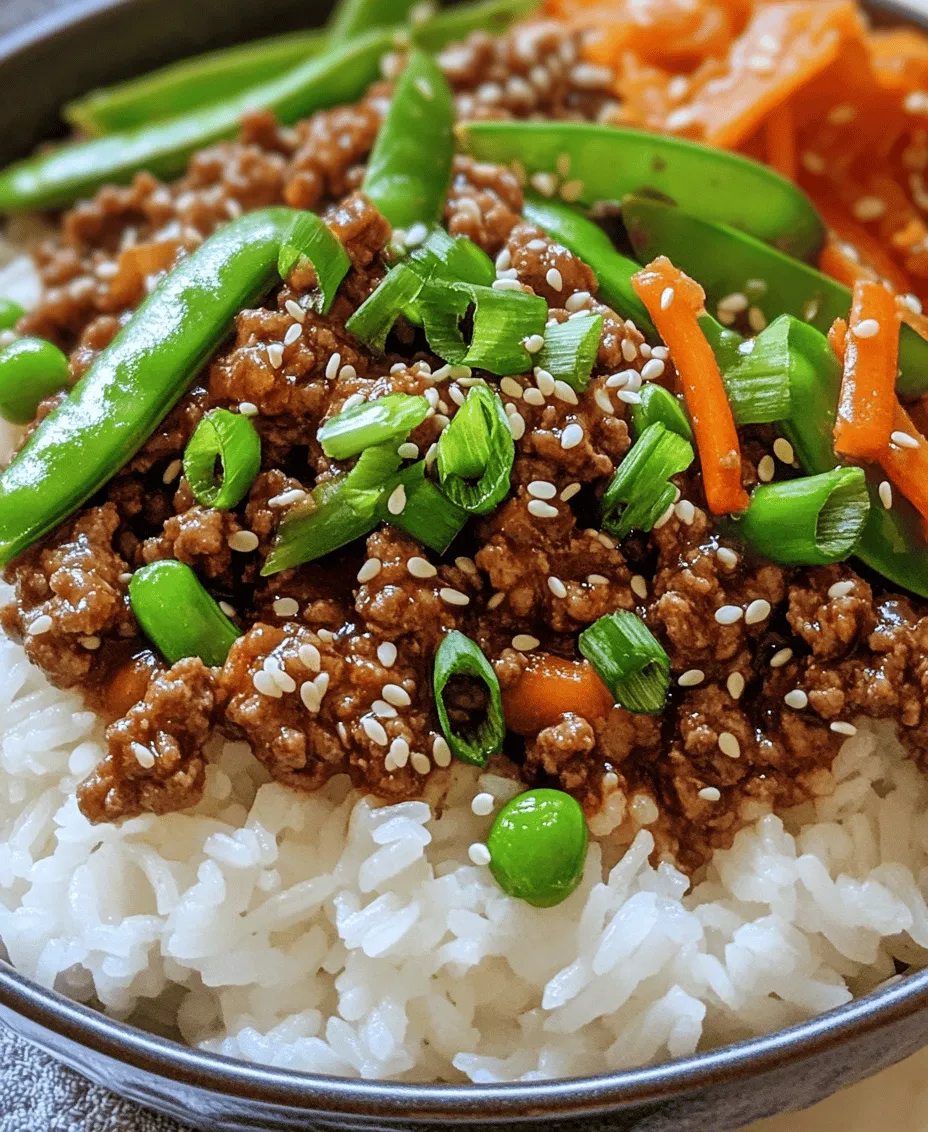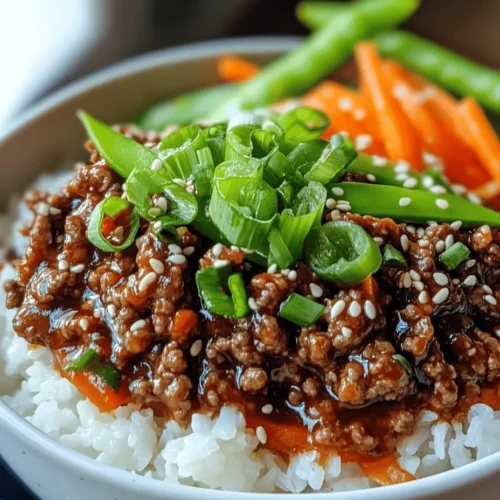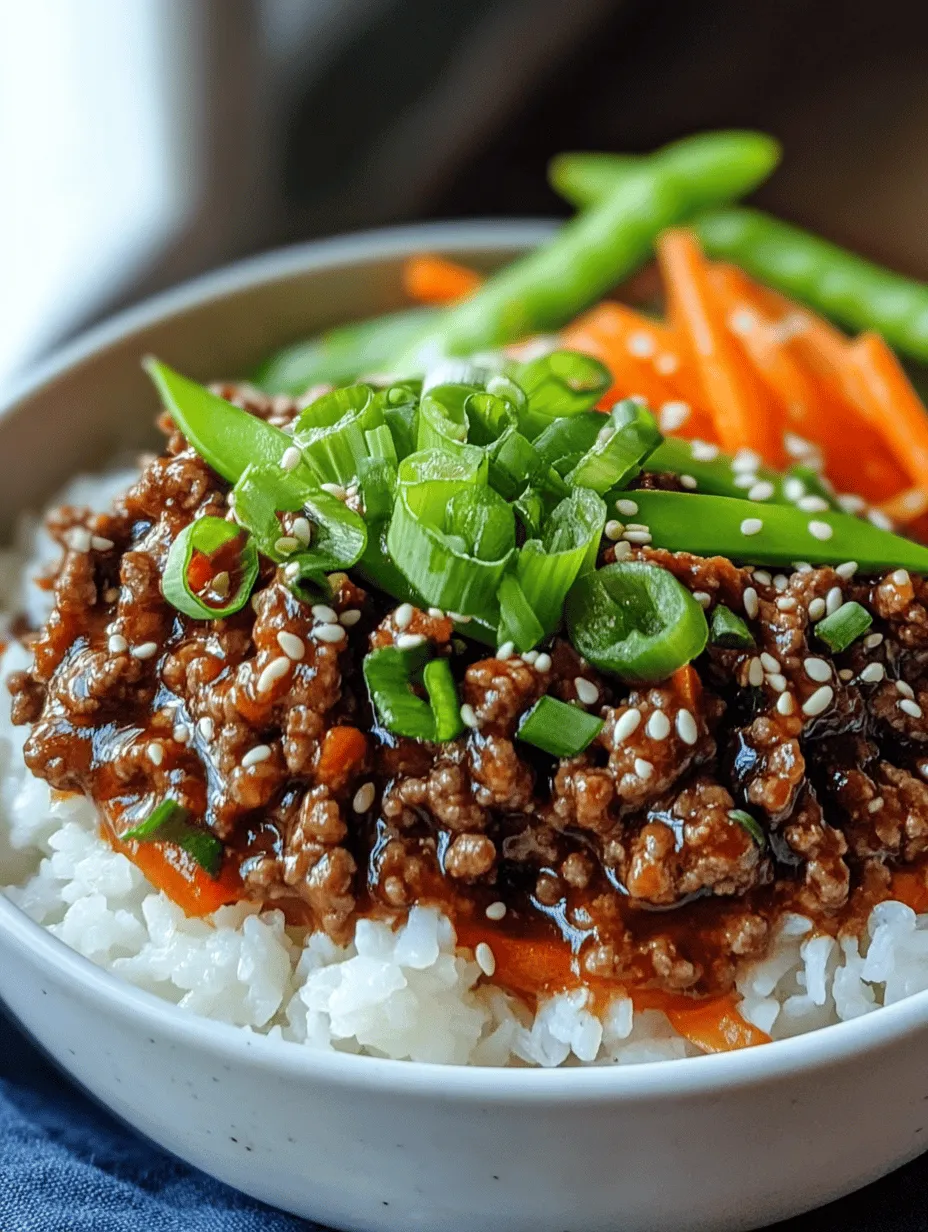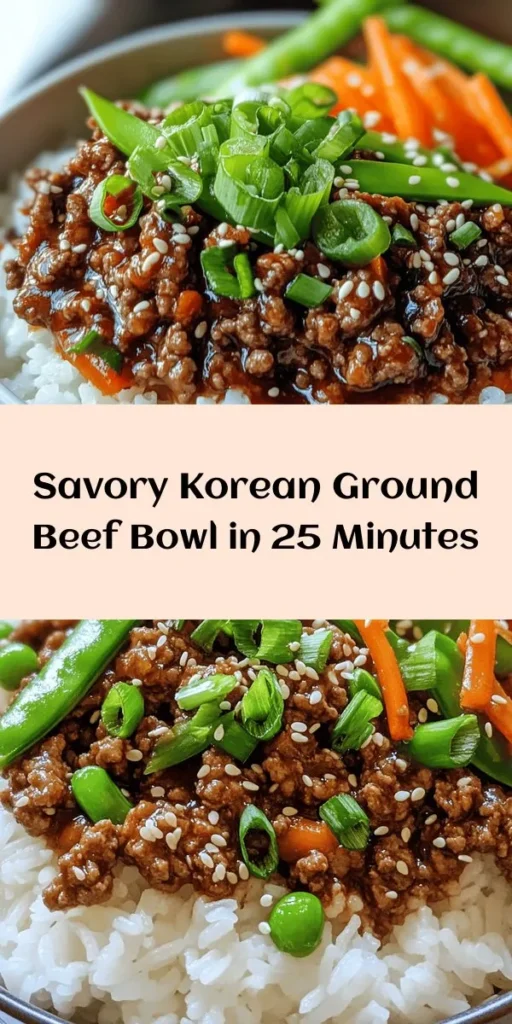Introduction
Korean cuisine has garnered immense popularity around the world, celebrated not only for its bold flavors but also for its vibrant colors and diverse textures. From the savory depth of kimchi to the sweet and spicy allure of bulgogi, Korean culinary traditions offer something for everyone. Among these delightful dishes is the Korean Ground Beef Bowl Delight, a quick and flavorful meal option that has become a favorite for families and food enthusiasts alike.
This dish is perfect for those busy weeknights when time is of the essence, yet you still want to enjoy a wholesome meal that tantalizes the taste buds. The Korean Ground Beef Bowl combines the rich flavors of seasoned ground beef with fresh vegetables, served over a bed of rice, making it a satisfying choice for both novice cooks and seasoned chefs. It comes together in a matter of minutes, allowing for both convenience and culinary enjoyment.
Whether you are looking to impress guests at a dinner party or simply want to treat yourself to a delightful homemade meal, this recipe is sure to become a staple in your cooking repertoire. Let’s dive into the ingredients and preparation steps that make this dish so irresistible.
Understanding the Ingredients
To create a truly authentic Korean Ground Beef Bowl Delight, it’s essential to understand the core ingredients that contribute to its rich flavor profile. Each component plays a vital role in achieving the perfect balance of savory, sweet, and spicy notes that Korean cuisine is known for.
Ground Beef
The primary protein in this dish is ground beef, and for optimal flavor and texture, it’s recommended to use an 80/20 lean-to-fat ratio. This balance allows for a juicy and flavorful bite, ensuring that the beef remains moist during cooking. The fat adds richness, while the lean meat provides the necessary protein, resulting in a well-rounded dish.
Aromatics
Garlic and onion are the foundational aromatics in many Korean dishes, including our Ground Beef Bowl Delight. These ingredients not only add depth but also enhance the overall flavor profile. When sautéed, garlic releases its pungent aroma, while onion provides sweetness and complexity. Together, they create a flavorful base that elevates the dish to new heights.
Soy Sauce and Brown Sugar
Korean cuisine often features a delicate balance of savory and sweet flavors, and this is expertly achieved through the use of soy sauce and brown sugar. Soy sauce brings umami richness to the dish, while brown sugar adds a touch of sweetness that contrasts beautifully with the saltiness of the soy. This combination is key to achieving that signature Korean flavor profile that makes each bite memorable.
Sesame Oil and Gochujang
No Korean dish is complete without the inclusion of sesame oil and gochujang. Sesame oil adds a nutty aroma and richness that enhances the overall flavor, while gochujang, a fermented chili paste, introduces a unique heat and depth. This ingredient is essential for achieving the authentic spiciness that Korean cuisine is known for, making it a must-have in your pantry.
Fresh Vegetables
Fresh vegetables are not just for color; they provide crunch and nutrition to your meal. Common choices for this dish include bell peppers, carrots, and broccoli. Their vibrant colors and textures not only make the dish visually appealing but also add layers of flavor that complement the seasoned beef. Using fresh produce ensures that each bite is crisp and satisfying.
Optional Garnishes
To elevate the presentation of your Korean Ground Beef Bowl, consider garnishing with sliced green onions and toasted sesame seeds. These toppings not only enhance the visual appeal but also add additional layers of flavor and texture. Green onions provide a fresh, sharp contrast to the richness of the beef, while sesame seeds add a delightful crunch.
Preparation Steps Explained
Now that we have a solid understanding of the ingredients, let’s delve into the preparation steps that will guide you towards creating a delicious Korean Ground Beef Bowl Delight. Each step is designed to maximize flavor and ensure that your dish comes together seamlessly.
Browning the Beef
Begin by heating a large skillet over medium-high heat. Once hot, add the ground beef, breaking it apart with a spatula as it cooks. The goal is to achieve a nice sear on the meat, which adds depth of flavor. Allow the beef to cook undisturbed for a few minutes, then stir to brown it evenly. This process typically takes about 5-7 minutes. Make sure to drain any excess fat if necessary, but retain some for flavor.
Sautéing Aromatics
Once the beef is browned, push it to one side of the skillet, and add a bit more oil if needed. Add minced garlic and diced onion to the empty side of the pan. Sauté them for about 2-3 minutes until the onion becomes translucent and the garlic is fragrant. This step is crucial, as it builds the foundational flavors of the dish. Be careful not to burn the garlic, as it can turn bitter.
Creating the Sauce
Next, it’s time to create the sauce that will bring everything together. In a small bowl, combine soy sauce, brown sugar, sesame oil, and gochujang. Stir until the sugar has dissolved completely. Pour this mixture over the browned beef and aromatics in the skillet, mixing everything thoroughly. Allow the sauce to simmer for a few minutes, so the flavors meld together beautifully. The sauce will thicken slightly, coating the beef and enhancing its flavor.
Adding Vegetables
Once the sauce is well incorporated, it’s time to add the fresh vegetables. Depending on the types of vegetables you choose, they may require different cooking times. For instance, bell peppers and carrots can be added early on, while more delicate vegetables like broccoli should be added a minute or two later. Stir-fry the vegetables with the beef for about 3-5 minutes, or until they are tender but still crisp. This timing is vital; you want the vegetables to retain their vibrant color and crunch.
Cooking Times and Techniques
Throughout the cooking process, keep an eye on the timing and adjust the heat as necessary. If the mixture begins to stick to the pan, reduce the heat slightly or add a splash of water or broth to deglaze. The goal is to create a cohesive, flavorful mixture without overcooking the beef or vegetables. By following these steps carefully, you will ensure that your Korean Ground Beef Bowl Delight is not only delicious but also visually appealing.
Flavor Profile Analysis
The Korean Ground Beef Bowl Delight is a harmonious blend of flavors and textures. The savory and slightly sweet notes from the sauce complement the rich, juicy beef, while the fresh vegetables add a satisfying crunch. The umami depth from the soy sauce and the unique kick from the gochujang create a well-rounded taste experience that is both comforting and exciting.
By carefully selecting quality ingredients and following these preparation steps, you will create a dish that embodies the essence of Korean cuisine while being quick and easy to prepare. Stay tuned for the next part, where we will explore the finishing touches and plating techniques to elevate your Korean Ground Beef Bowl Delight to perfection.

Korean cuisine is known for its bold flavors and unique ingredients, and the Korean Ground Beef Bowl Delight exemplifies this culinary tradition. This dish is not only a feast for the palate but also an exploration of umami, the savory taste that makes it so satisfying. The perfect balance of flavors comes from the harmony of the ingredients, particularly the influence of gochujang, a staple in Korean cooking.
Exploration of the Umami Taste in the Dish
Umami is often described as the fifth taste, alongside sweet, salty, sour, and bitter. It’s a flavor that can be difficult to define but is undeniably present in many beloved dishes, including our Korean Ground Beef Bowl Delight. The umami in this dish comes from a combination of ingredients such as soy sauce, sesame oil, and the gochujang. Each of these adds depth and richness, creating a savory experience that lingers on the palate. The ground beef contributes a hearty and satisfying element, while the vegetables provide freshness and a slight crunch, enhancing the overall taste profile.
How the Ingredients Work Together to Create a Harmonious Flavor Balance
Every ingredient in the Korean Ground Beef Bowl has a role to play in creating a well-rounded dish. The ground beef serves as the protein base, enriched with flavors from garlic, onion, and ginger, which add aromatic qualities. The soy sauce not only infuses the beef with saltiness but also adds an earthy note, while the brown sugar balances the salt with a touch of sweetness.
The gochujang, a fermented chili paste, introduces a complex layer of heat and sweetness that elevates the dish beyond mere spiciness. It works in tandem with the sesame oil, which adds a nutty flavor that rounds out the dish beautifully. The vegetables—typically bell peppers, carrots, and green onions—are not just for color; they contribute essential nutrients and textural contrast, creating a delightful bite with every spoonful.
The Influence of Gochujang on Spice Levels and Overall Flavor Complexity
Gochujang is a cornerstone of Korean flavor profiles, known for its ability to add depth and complexity to dishes. In the Korean Ground Beef Bowl Delight, it plays a crucial role in determining the spice levels. Depending on the amount used, you can control how spicy you want the dish to be, making it adaptable to various taste preferences.
Beyond its heat, gochujang also imparts a rich sweetness, thanks to its fermentation process, which enhances the overall flavor complexity. This combination of spice and sweetness makes the dish irresistible and encourages diners to return for seconds.
Nutritional Information
In addition to its delightful flavors, the Korean Ground Beef Bowl Delight is nutritionally robust. Each serving offers a balance of macronutrients that supports a healthy diet.
Overview of Nutritional Value per Serving
A typical serving of this dish contains approximately 400-500 calories, varying based on the amount of beef and vegetables used. Here’s a breakdown of the macronutrients:
– Protein: 25-30 grams (from ground beef, a great protein source)
– Carbohydrates: 40-50 grams (primarily from rice and vegetables)
– Fats: 15-20 grams (with healthy fats coming from sesame oil)
Health Benefits of Key Ingredients
– Ground Beef: A fantastic source of high-quality protein, iron, and zinc, essential for muscle health and immune function.
– Vegetables: Bell peppers and carrots are rich in vitamins A and C, while green onions provide additional antioxidants and anti-inflammatory properties.
– Gochujang: Contains probiotics from fermentation, which can promote gut health.
Discussion on the Dish’s Suitability for Various Diets
This dish can be adapted for various dietary preferences. For those following a high-protein diet, using lean ground beef or turkey increases protein content while reducing fat. For a low-carb option, substituting rice with cauliflower rice offers a lighter alternative without sacrificing flavor. Even vegans can enjoy this dish by replacing the beef with tofu or tempeh, maintaining the umami essence with gochujang and soy sauce.
Serving Suggestions
To enhance the meal experience of your Korean Ground Beef Bowl Delight, consider these delicious accompaniments.
Ideal Accompaniments to Enhance the Meal Experience
1. Cooked Rice: The foundation of the bowl, rice absorbs the flavorful sauce and balances the seasoning. You can choose between white rice for its soft, sticky texture or brown rice for a nuttier flavor and additional fiber. Brown rice also brings a heartier feel to the dish, making it even more satisfying.
2. Kimchi: No Korean meal is complete without kimchi. This traditional fermented side dish, made from seasoned vegetables (usually napa cabbage and radishes), adds a tangy crunch that complements the savory beef bowl. Moreover, kimchi is packed with probiotics, which can aid digestion and promote gut health.
3. Creative Variations on the Recipe: Feel free to experiment with the base recipe. Using ground turkey instead of beef can lighten the dish while still delivering excellent flavor. For a vegetarian option, tofu or tempeh can be marinated in soy sauce and gochujang to capture the essence of the original recipe. You can also incorporate seasonal vegetables like zucchini or snap peas for added nutrition and texture.
Cultural Context
Understanding the cultural significance of dishes can deepen your appreciation for them. In Korean cuisine, ground beef has a long history, often celebrated for its versatility and flavor. It is commonly used in various forms, from stir-fries to stews, making it a beloved protein choice in many households.
The Significance of Bowls in Korean Dining Culture
In Korea, serving food in bowls is a tradition that emphasizes communal dining. Dishes are often shared among family and friends, contributing to a warm, inviting atmosphere. The Korean Ground Beef Bowl Delight fits perfectly into this culture, as it encourages sharing and enjoying food together, fostering connection and community.
How This Dish Fits into the Broader Spectrum of Korean Comfort Foods
This dish represents the essence of Korean comfort food—simple yet flavorful meals that evoke nostalgia and warmth. Its balance of savory, spicy, and sweet flavors makes it a go-to for many families, especially on busy weeknights. The ability to customize it with different proteins and vegetables adds to its appeal, allowing families to create their versions based on preferences and dietary needs.
Conclusion
The Korean Ground Beef Bowl Delight is a perfect representation of the rich tapestry of flavors found in Korean cuisine. Its umami-rich taste, balanced ingredients, and ability to adapt to various dietary preferences make it a delightful meal for everyone.
As you explore this recipe, consider the joy of cooking and sharing meals with loved ones. Whether you’re a seasoned cook or new to the kitchen, this dish invites you to experience the vibrant flavors of Korea right at home. Try making this bowl for your next family dinner, and enjoy the process of creating a meal that brings everyone together. With each bite, you’ll not only savor the taste but also share in the cultural richness that makes Korean food so special.



